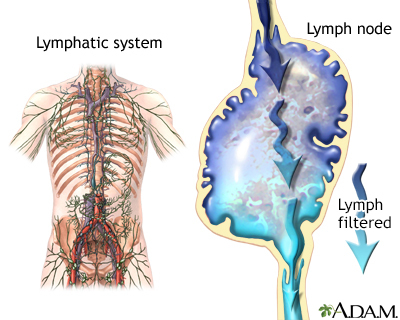Lymph system
Definition
The lymph system is a network of organs, lymph nodes, lymph ducts, and lymph vessels that make and move lymph from tissues to the bloodstream. The lymph system is a major part of the body's immune system.
Alternative Names
Lymphatic system
Information
Lymph is a clear-to-white fluid made of:
- White blood cells, especially lymphocytes, the cells that attack bacteria in the blood and body tissues
- Fluid from the intestines called chyle, which contains proteins and fats
Lymph nodes are soft, small, round- or bean-shaped structures. They usually cannot be seen or easily felt. They are located in clusters in various parts of the body, such as the:
- Neck
- Armpit
- Groin
- Inside the center of the chest and abdomen
Lymph nodes mainly store immune cells that help the body fight infection but are also places where these cells can be made. They also filter the lymph fluid and remove foreign material such as bacteria and cancer cells. When bacteria are recognized in the lymph fluid, the lymph nodes make more infection-fighting white blood cells. This causes the nodes to swell. The swollen nodes are sometimes felt in the neck, under the arms, and groin.
The lymph system includes the:
- Tonsils
- Adenoids
- Spleen
- Thymus
Gallery


References
Ball JW, Dains JE, Flynn JA, Solomon BS, Stewart RW. Lymphatic system. In: Ball JW, Dains JE, Flynn JA, Solomon BS, Stewart RW, eds. Seidel's Guide to Physical Examination. 10th ed. Philadelphia, PA: Elsevier; 2023:chap 10.
Hall JE, Hall ME. The microcirculation and lymphatic system: capillary fluid exchange, interstitial fluid, and lymph flow. In: Hall JE, Hall ME, eds. Guyton and Hall Textbook of Medical Physiology. 14th ed. Philadelphia, PA: Elsevier; 2021:chap 16.